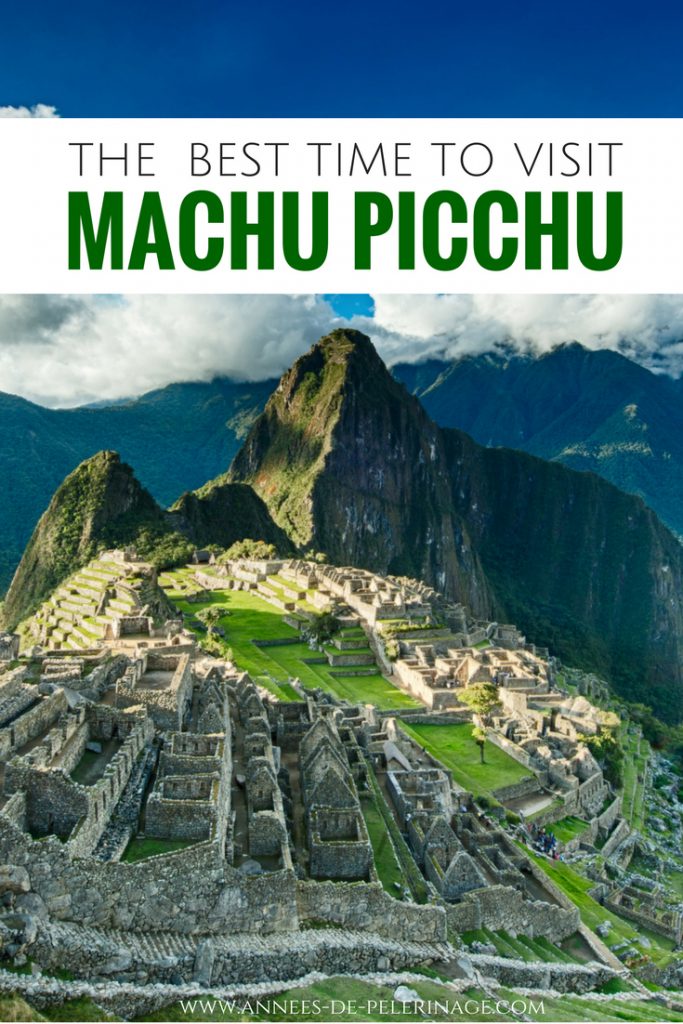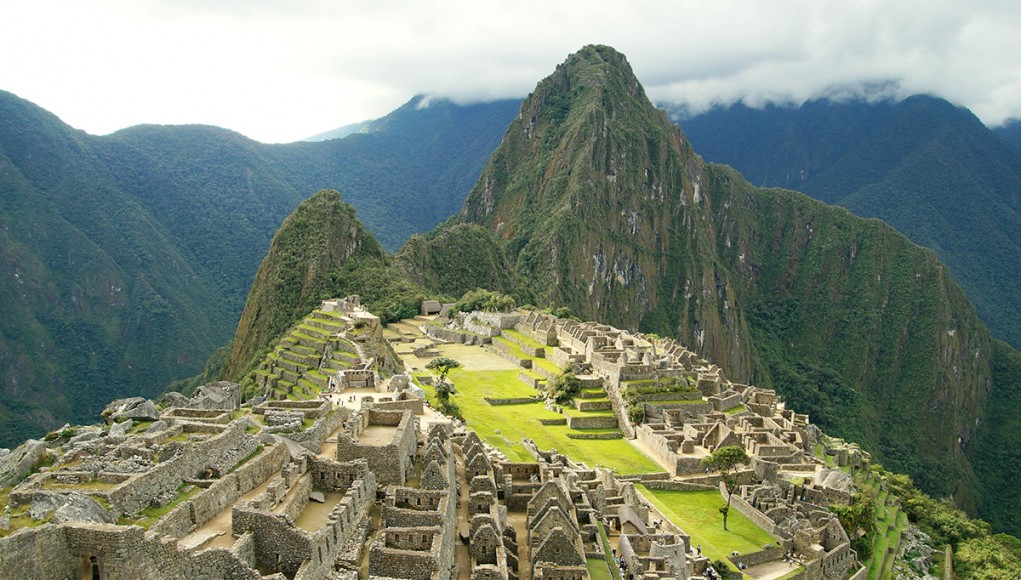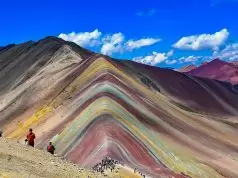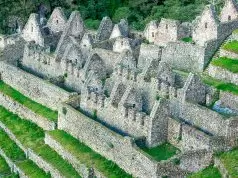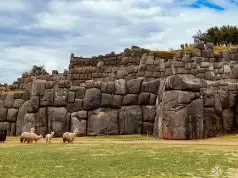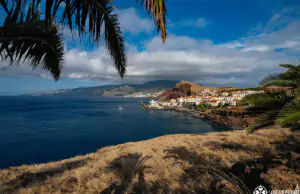Everything you need to know about the weather in Machu Picchu & the best time to visit.
The perhaps most crucial aspect of any trip to Peru is a good weather in Machu Picchu. More than one million people visit the famous Inca ruins per year. But not all of them are lucky enough to see Machu Picchu in bright sunshine. Rain, clouds, and mist often obscure the picture-perfect view. Careful preparation and choosing a good time to visit will increase your chances of having an amazing time in Machu Picchu by a hundred times (make sure to check out my ultimate Machu Picchu packing list to come prepared for any weather). Here is what you need to know about the Machu Picchu weather.
Machu Picchu weather: Averages & climate diagrams
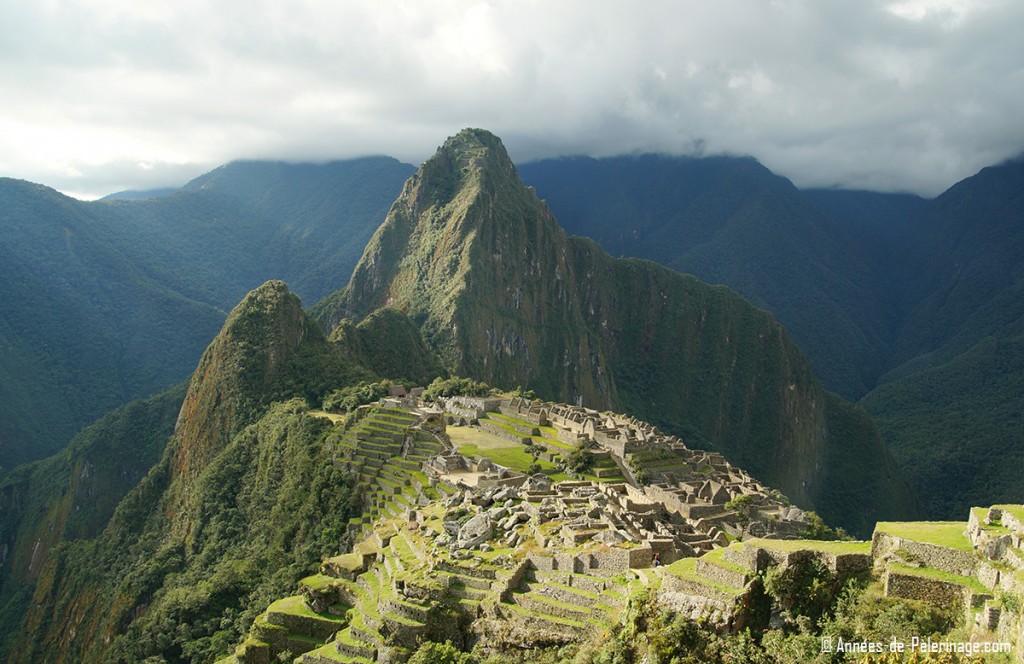
Before I book flights tickets or accommodations for any destination, I always have a look at a climate diagram. You should not treat a trip to Machu Picchu any different. Actually, since Machu Picchu is such an expensive destination, you should invest a couple of extra hours to research your trip thoroughly (Just in case: Here is my ultimate guide to Machu Picchu).
Before you take a look at the climate diagrams below, I’d like to stress one thing: Machu Picchu is located on a precarious mountain ridge at the junction between the Andean Highlands and the foothills of the Amazon Basin. The high humidity from the tropical jungle and the colder winds from the mountains create a very unpredictable climate that is characterized by frequent and fast changes. Even during the dry season, the day can start very foggy, see a sprinkle of rain at noon and end with perfect sunshine in the afternoon.
Also, a note of the mythology. There is no significant climate data available for Machu Picchu itself. This is data for Ollantaytambo. Most sources use data from Cusco or a mix, which is 100 kilometers away. This doesn’t sound like a lot, but sitting in the train from Cusco to Machu Picchu, you will notice a very drastic difference in vegetation. Even though I got no means to prove it, Machu Picchu is, in fact, a lot wetter & more humid than the diagrams below suggest. If you are looking for reliable info on Machu Picchu’s weather by month, I feel the data from Ollantaytambo is your best bet, but you will have to add a bit!
Machu Picchu weather by month – a quick overview
Before I give you a detailed breakdown of the weather in Machu Picchu, here’s a quick overview. Temperatures are fairly the same throughout the year, so I did not mention them.
- Machu Picchu weather January: Will be extremely wet, very high humidity, and little sunshine, considerably warm at night (10° C)
- Machu Picchu weather February: Wettest month of the year, high humidity & little sunshine, considerably warm at night (10° C)
- Machu Picchu weather March: Will be extremely wet, very high humidity and not too much sunshine, considerably warm at night (10° C)
- Machu Picchu weather April: Transition month; some rain, high humidity, considerably warm at night (10° C)
- Machu Picchu weather May: Start of the dry season, little rain, high humidity, a lot of sunshine, starting to get cold at night
- Machu Picchu weather June: Middle of the dry season, very little rain, lower humidity, a lot of sunshine, cold at night (reaching the freezing point)
- Machu Picchu weather July: Height of the dry season, almost no rain, lower humidity, a lot of sunshine, very cold at night (sometimes below to the freezing point)
- Machu Picchu weather August: End of the dry season, little rain, medium humidity, a lot of sunshine, still pretty cold at night
- Machu Picchu weather September: Transition month, medium rain, high humidity, quite a lot of sunshine, getting warmer at night
- Machu Picchu weather October: Start of the rainy season in Machu Picchu, quite a lot of rain, high humidity, considerably warm at night
- Machu Picchu weather November: will be very wet, very high humidity, not much sunshine, and warm at night (11°C)
- Machu Picchu weather December: will be extremely wet, very little sunshine, very high humidity, and quite warm at night
Average monthly rainy days in Machu Picchu
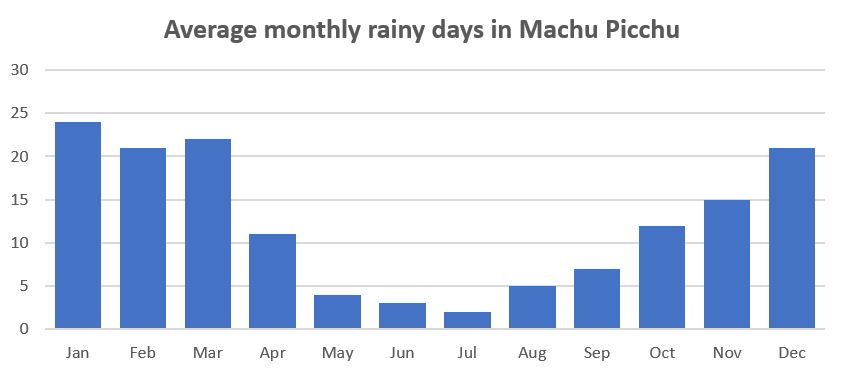
The bad news ahead: Machu Picchu is located inside a mountain rain forest. This means, that rains can occur throughout the whole year. If you take a close look at the chart above, you will notice that May to August sees almost no rain. These months are called the dry season and are, generally speaking, the best time to visit Machu Picchu.
Even though Machu Picchu will be quite striking no matter when you visit, you should know there is a rainy season in Machu Picchu. Between November and February, rainfalls occur almost on a daily basis.
Average humidity in Machu Picchu
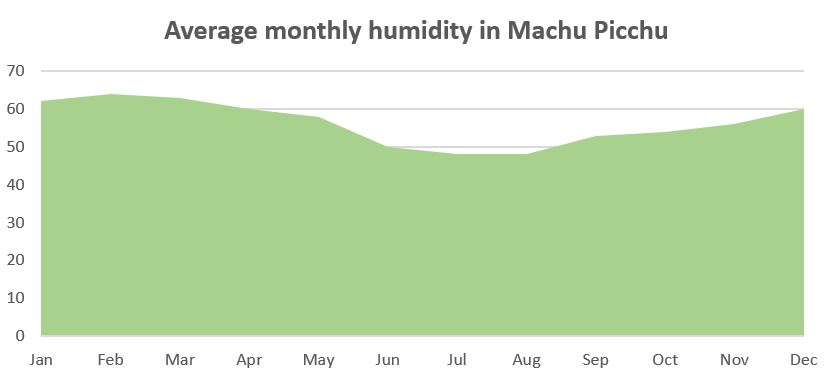
The second most important Machu Picchu climate diagram is the humidity chart. As you can see, humidity is fairly high throughout the year. It does not reach the extreme heights of the Amazon Rainforest on the other side of the Andean mountain range, but values of more than 50 percent can be observed throughout the year.
Why is this important? Due to the dense vegetation and the high humidity, morning mists are very frequent in Machu Picchu. In fact, the Inca ruins will be hidden behind a deep veil of fog on 2 out of three mornings.
If you are short on time, rather plan your itinerary in such a way that you can enjoy a full afternoon. Chasing after the sunrise in Machu Picchu (that you can’t even see, as the sun is hidden behind a mountain), often ends up with the crowds seeing nothing but fog. Until 10 o’ clock, the fog usually dissipated.
Average daily hours of sunshine in Machu Picchu
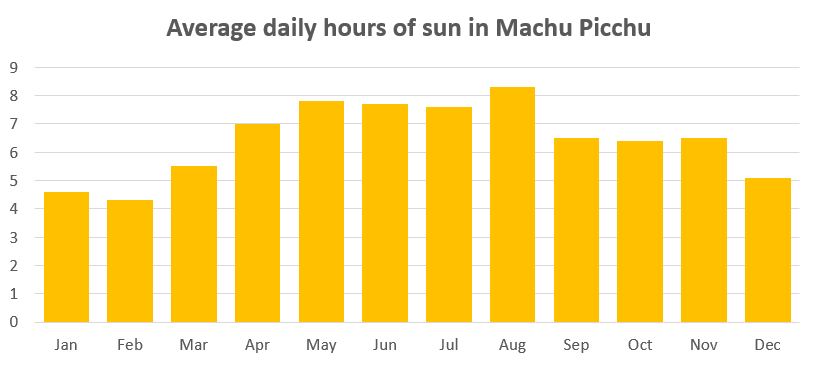
This diagram means good news. Even during the height of the rainy season, there are still more than 100 hours of sunshine in February. Certainly, the numbers are still in favor of the dry season, but a trip during the wetter months of the year has still quite a high chance of seeing the sun peeking through ever so often.
Average minimum and maximum temperature in Machu Picchu
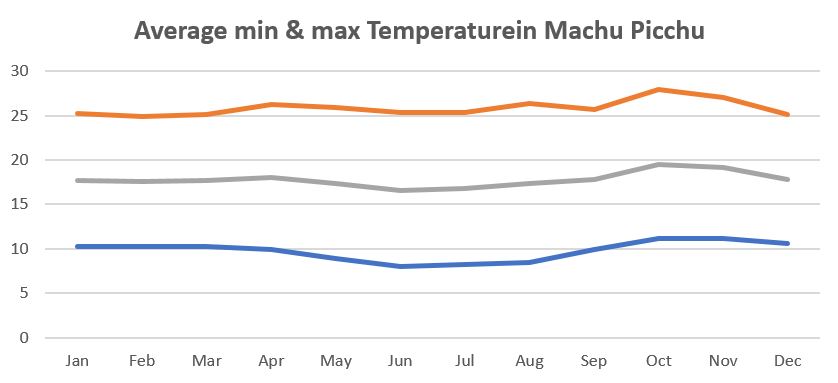
Machu Picchu is located quite close to the equator. So, the temperatures in Machu Picchu are fairly moderate throughout the year. As the Incas built the citadel at an altitude of 2,400 meters, nights can be quite cold, though. Especially during the dry season, it is advised to pack a warm poncho or jacket for the evenings. Temperatures sometimes even drop below the freezing point.
Average monthly precipitation in Machu Picchu
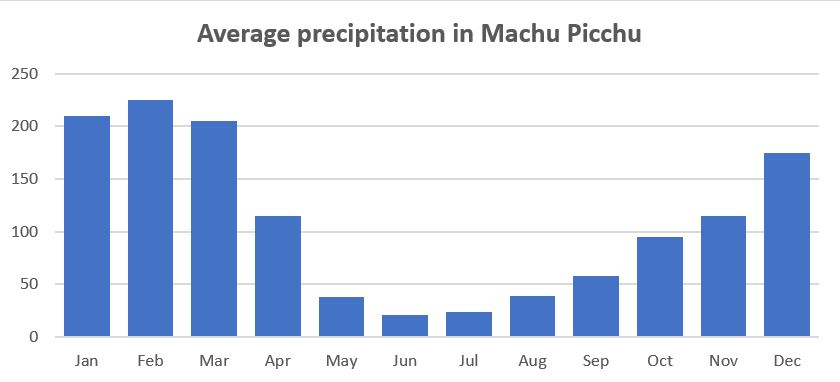
Again: Rain is quite common in Machu Picchu. But if you take a closer look at this chart, you will begin to understand, that rain falls during the dry season rarely last more than an hour or two. During the rain season, however, rainfalls can be so strong that mudslides occur. In fact, this is the reason why parts of Machu Picchu are closed in February (more below).
Best time to visit Machu Picchu
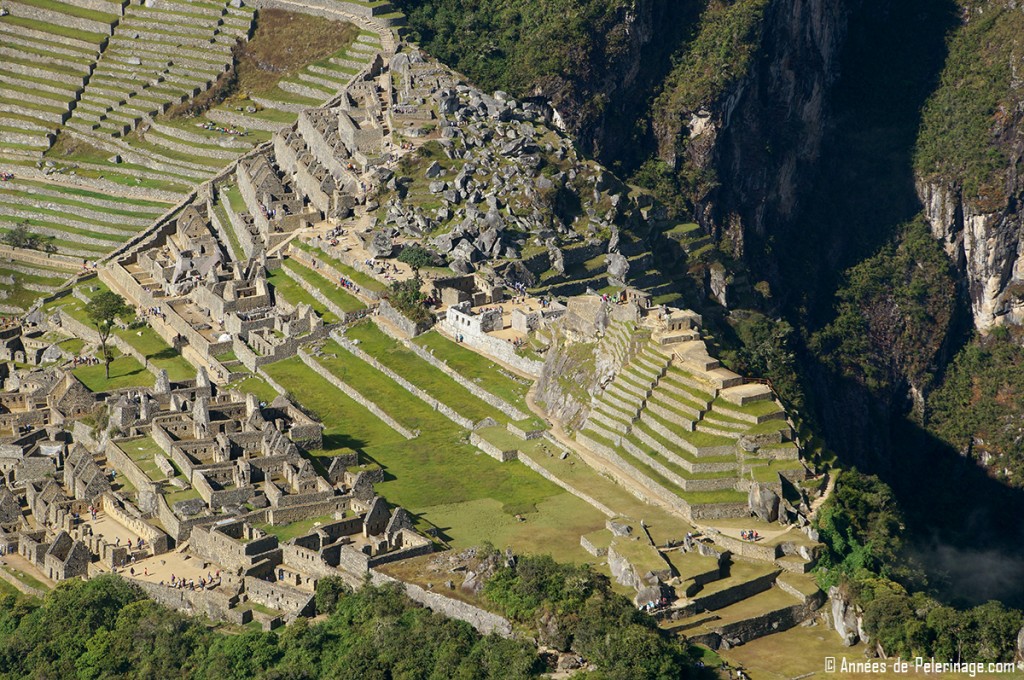
The best time to visit Machu Picchu is by far June and July. On average, these are the months with the least chance of rainfall, the most hours of sunshine and quite favorable daytime temperatures.
But, as always, this is only half of the story. June and July are also the months where hotels and Inca Trail tours sell out fastest. Tickets for Huanya Picchu (and even Machu Picchu itself) are also often booked out months in advance. Especially around noon, Machu Picchu will be very crowded during the height of the dry season.
This is why mid-April to May and August to mid-September might actually be the better options. There is still a low enough chance of rainfall to have an enjoyable stay in Machu Picchu & beyond, but the ruins will be less crowded, hotel prices will be lower and tickets won’t sell out as fast.
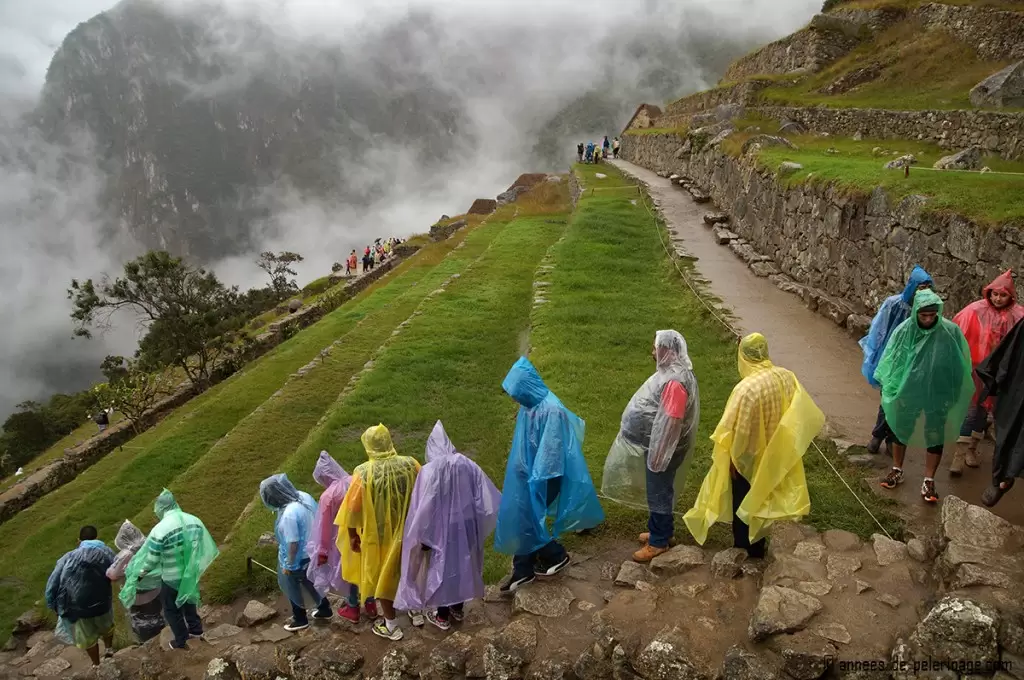
My common acceptance, February is the worst month to visit Machu Picchu. The Inca Trail is closed during this month, as well as the hike up to Huyana Picchu. The heavy rainfalls render the paths quite treacherous, but the Peruvian Ministry of Culture also uses February for maintenance works.
During January and December, the Inca Trail will be open, but you should be prepared for some very rainy 5 days on the road. Bring water resistant clothes and make sure to have spares for each item, as they will take ages to dry.
That being said, a visit to Machu Picchu will be magical the whole year. It is one of the few New World Wonders that over delivers on its promise rather than disappoint. You will never truly forget the moment you catch your first glimpse of the ruins. Also know, that the Incas equipped Machu Picchu with a perfect drainage system. For obvious reasons, you will only be able to see this in action during the rainy season!
Reading recommendation for Machu Picchu
Now that you figured out the ideal time to visit Machu Picchu, it’s time to start preparing your trip in earnest. Here are a couple of my posts that will help you.
- Machu Picchu facts & pictures
- Huayna Picchu: How to climb the mountain behind Machu Picchu
- Belmond Sanctuary Lodge – The best hotel in Machu Picchu
- The dark side of Machu Picchu
- How long does it take to hike Machu Picchu?
- Huayna Picchu death toll – Facts & Myths
- What to pack for Peru?
- 10 ways to prevent altitude sickness in Machu Picchu
- Machu Picchu morning ticket or afternoon ticket – which is better?
Hope I was able to help you with my article on the weather in Machu Picchu. If you still got any questions, feel free to ask them in the comments below. And don’t forget to pin this article for later!
